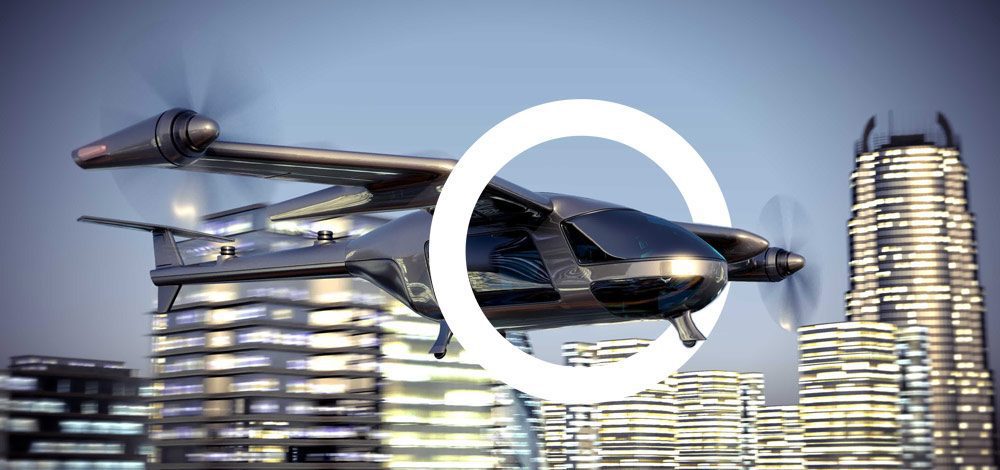For decades, ‘flying cars’ in futuristic cityscapes have been a staple of science fiction. However, many of the most outlandish ideas of the genre have now become reality. In Back to the Future Part II, when Marty McFly and Doc travel to the year 2015, they experience a world with what seemed like fantastic inventions 30 years ago when the film launched.
However, one of the most memorable pieces of technology from the film, still hasn’t arrived: Air Taxis. Yet, in the year 2019, that vision remains a preoccupation for many aviation engineers and investors. Among the many fascinating areas of aerospace research and development, the other powerful trends that we see gathering momentum through 2019 involve some of the key technologies required to support short-range air commuting and the proliferation of drones, as well as the technologies required to police them.
We are also witnessing a new kind of space race – not between nations – but a private competition to open up space travel to the masses, and inspired by the free market’s entrepreneurial galacticos.
Urban Aerial Mobility (UAM) – cross-city or sub-regional flights across relatively short distances – is not a new concept. However, the increasingly congested roads of our megacities only give the efforts to achieve it greater impetus.
Aerospace engineers and mobility moguls see this potential for ‘air taxis’ to fly over traffic and reduce congestion, and to provide easier access and quicker response times in emergencies for air ambulances or high-rise fire and rescue teams. However, aircraft types as we know them are not suitable for this role;
- Aeroplanes need large runways and other infrastructure that cannot be easily accommodated within major cities. They also need an unobstructed flight path which limits the construction of high-rise buildings in the vicinity and makes city planning harder.
- Helicopters can and do act as air taxis but are far more expensive to operate than aeroplanes on a mass scale. Even small 2-seater helicopters need approximately 30 hours of maintenance for every 100 hours of flight, due to the complexity of the mechanical systems that create the rotary motion of the blades. They also generate a lot of noise pollution. In any case, the potential hazard from multiple helicopters with unguarded rotary blades prevents high numbers of these flying in proximity to buildings or each other.
To overcome these challenges, innovators around the world are instead focusing on electric vertical take-off and landing (eVTOL) aircraft, which are cleaner, quieter and safer than helicopters. The mechanical complexity of an electric drivetrain is much simpler than that of a helicopter and the resulting maintenance and operation costs are significantly cheaper. These aircrafts can be used to transport passengers at much higher volumes than existing helicopters and globally, there are now more than 100 companies developing different configurations to compete in this new mobility market.
Big players in the eVTOL space include Bell Nexus, Aurora Flight Sciences, Airbus CityBus and its Silicon Valley subsidiary A3 Vahana. It’s remarkable however that most progress appears to be coming from smaller start-ups that are challenging industry incumbents for dominance in this new age of aviation. German start-ups Lilium Aviation and Volocopter have raised €100m and €30m respectively and have already begun flight testing of full-scale aircraft, while Joby Aviation has raised $130m and is racing ahead of the aerospace giants.
The upwardly mobile include another familiar force; Uber has created its own initiative, Uber Elevate, which aspires to run an air taxi service ferrying 4-5 passengers at a time between the suburbs and city centres. Uber’s ambitious timetable is for roll-out – most likely in Dallas and Los Angeles initially – by 2023, but questions remain over the maturity of technologies for commercial operation.
Looking at other applications, thrill-seekers are no longer limited to jet skis and quadbikes. Smaller eVTOL aircraft – such as the Kittyhawk Aero Flyer, Pivotal Helix, Lift HEXA and Hoversurf S3 Hoverbike – due to their size, can already fly in the US without any regulation. While not suited for the role of air taxis, they are useful technological test beds, as well as recreational vehicles for the wealthy and are becomingly increasingly available for experience days.
Looking to the long term, a series of studies by respected consultants – including Roland Berger, McKinsey, Porsche Consulting and Deloitte – believe that eVTOLs could become as commonplace as the car. However, there are still some major aerial roadblocks.
Even when the technology is proven, regulators must come to terms with its usage and as a result, and it may not enter the mainstream for at least another 5 to 10 years, regardless of technology maturity.













No Comments